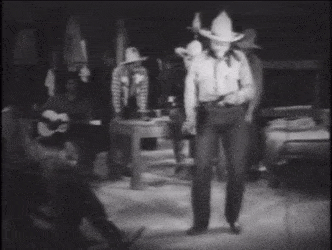From the 1920's to the 1950's era of Jim Crow era segregation there existed a network of movie theatres in black communities just as there was an older network of black vaudeville and music halls known as the Chitlin Circuit that featured black music, dance and comedy acts. These theatres meant that there was an audience for all-black movies as well so by the 1930's there were made a series of films with all-black casts, usually made by black directors to fill this niche. These films were rarely seen by white audiences, did not make it to TV and have been largely fogotten.
In the silent era director Oscar Michaud (who I already wrote about here) started things off with his response to DW Griffith's "Birth Of A Nation" and continued to make films into the sound era. His films were serious minded and intended to offer messages of moral and racial uplift, sometimes with a religious subtext. Others would make films of a decidedly less serious nature, especially actor/writer/producer Spencer Williams who made a number of low budget comedies as well as the "Son Of Ingagi" horror film. Equally low-budget musicals (including some starring Cab Calloway and Louis Jordan), musical revues and Film Noir crime films were also made but the most popular, and oddest films, were a series of westerns made in the late thirties and early forties starring singer Herb Jeffries.
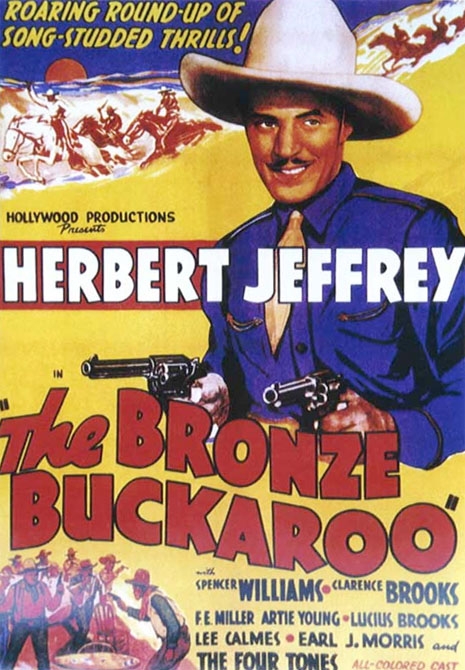
By this point the western genre was largely dominated by a distinct brand of low-budget quickie musical "oaters", which featured silly cookie-cutter plots, rote direction, wooden acting, and decidedly non-threatening levels of mild cartoon violence. These films were hugely successful with kids in particular and made stars out of names like William Boyd, a silent screen veteran who saw his career revive when he became "Hopalong Cassidy", former football player Johnny Mack Brown, former bit player John Wayne and former rodeo star Ken Maynard. It was Maynard who accidentally kicked off a new western musical genre when he warbled a couple of songs in a 1930 film and followed it up with a few more in which he sang and played guitar or fiddle. Maynard was not a real musician and while he did make a few recordings had no real desire to be one. He did however inspire another cowboy singer named Gene Autry to move to Hollywood and start a film career that would easily eclipse Maynard's, making a series of singing cowboy movies that would run to 93 movies over the next thirty years. Almost all Autry's films were identical, with childishly simple plots and most of the same casts. Autry himself was, by his own admission, fairly limited as a singer, not much of an actor and even less of a cowboy who often fell off his horse and could not throw a believable punch. But he was affable, looked flashy in his tailored cowboy suits and white hat and he had a collection of catchy songs. The success of these low budget quickies is a little difficult to understand now as most are blandly interchangeable and forgettable (the notable exception being "Secret Empire" an odd sci-fi western serial which I will have to write about in the future) but in every film Autry will stop the action (such as it is) to croon a cowboy tune or two and many of these songs became genuine hits and even classics including "Back In The Saddle" and "Rudolph The Red Nose Reindeer". The obvious success of these cheaply made films, even among black audiences, (even some Blues singers admitted to being Autry fans) meant that at some point somebody was bound to find a black version.

Herb Jeffries was always somewhat cagey about his background. Although at times he claimed to be a "Creole from New Orleans", census reports show he was in fact born in Detroit in 1913 under the name of Umberto Alexander Valentino. His mother was Irish and ran a rooming house and his father, who left before or shortly after his birth was described as being of variously mixed French, Scilian, Ethiopian and Moorish background and that he had died in WW1. How much of this is true is anybody's guess and it is entirely possible that Jeffries never really knew, it was common at the time for Black entertainers to claim "Ethiopian" or "Moorish" roots as these were among the only African nations to escape slavery and such roots were seen as noble although modern DNA tests show this was rarely, if ever, actually true. What is certain is that Jeffries had light enough skin that he could pass for a Creole and often did although he always insisted he never passed for white. He grew to be tall and handsome with a trim moustache, an elegant, dignified bearing, and a smooth voice. At some point he started billing himself as either Herb Jeffries or Herb Jeffrey, a practice he would continue in his film acrrer. After leaving school in 1929 he took pickup gigs in speakeasies singing Jazz and popular ballads and dancing where he caught the eye of Louis Armstrong who recommended him for a regular gig singing with bandleader Erskin Tate in Chicago where he was quickly hired away for more money by Earl Fatha Hines for a tour and still later would also get signed by Duke Ellington, with whom he would make several recordings.
"FLAMINGO" ~ DUKE ELLINGTON & HERB JEFFRIES (1941)
By the mid-thirties Jeffries was successful enough to try his hand at the movies. Although his entire background had been in Big Band Jazz and popular ballads and other Jazz artists had made film appearances where they essentially played themselves in a Jazz context including Ellington, Armstrong and Cab Calloway, Jeffries had something very different in mind. While he was a city boy born & bred, like so many others both black and white, he had grown up watching the silent Westerns of Tom Mix, Tom Holt, Jack Hoxie and Art Acord and he had seen the transition to the singing cowboy Gene Autry who was hugely successful. Jeffries noticed something that the studios had not, that these films were just as popular with black audiences as they were with white ones and he spotted an opportunity. These films were not especially difficult to make; they had small budgets, simple sets, repetitive stories, could easily recycle the same casts, costumes and sets and could be made cheaply and quickly. Still none of the existing studios, even the poverty row studios that churned out these B-movie westerns every couple of months showed any interest so Jeffries roped in Spencer Williams.
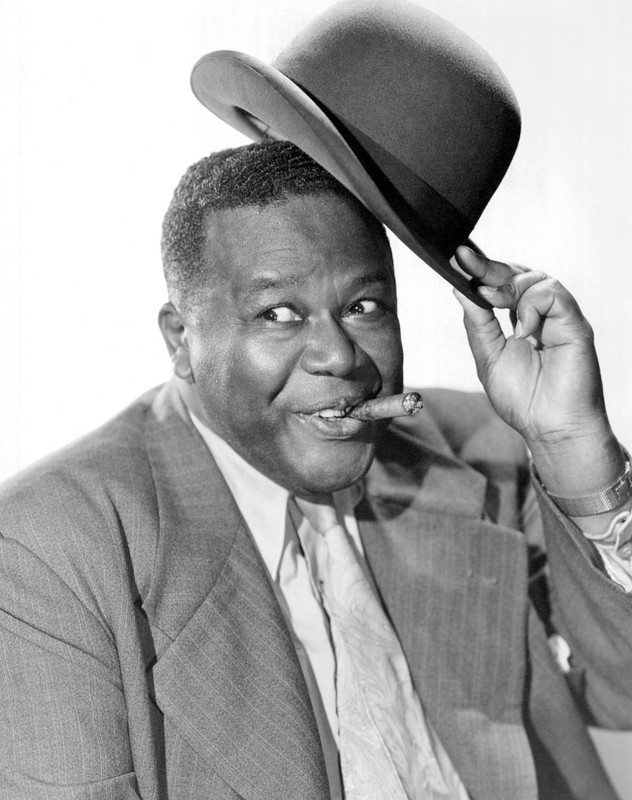
SPENCER WILLIAMS
Williams (1893-1969) was a veteran black actor, comic and filmmaker with a career going back as a comedian in vaudeville who had already been making all-black films since the start of the sound era with some success in the black community. He was a large, heavyset man who usually played heavies or buffoons and his films ranged from comedies to musicals and crime films in which he not only acted but also often wrote and directed. He had even worked on the 1928 film "Queen Kelly" starring Gloria Swanson and directed by Eric Von Stroheim where he was in charge of casting and rehearsing the black cast members. Note that this Spencer Williams is not to be confused with another contemporary Spencer Williams (1889-1965) who was a successful Jazz musician and composer but who did not appear in films. To avoid confusion Spencer the actor would bill himself as Spencer Williams Jr.
To secure funding Jeffries approached Jed Beull, a white producer of independent B-Movies who had previously worked for Mack Sennett and who had already produced a B-Movie western. Jeffries offered himself as the star with Williams playing the comic relief sidekick, a role common to Autry movies. Added to the cast would be two more veteran performers from black vaudeville. Flournoy Miller (1885-1971) was another comic from vaudeville who had been successful enough to start his own production company and write a musical "Shuffle Along" with music from early Jazz and Ragtime composers Eubie Blake and Noble Sissle which became a long running Broadway hit in 1921. He would later work on other musicals with Jazz greats James P Johnson and Fats Waller. Miller would also be credited with co-writing the script for Jeffries first film. Mantan Moreland (1902-73) was yet another vaudeville comic and sometime partner of Miller who had made the transition to film with a string of comic relief sidekick roles including in mainstream white films where he was known for his moonfaced eye-rolling double-takes and squeaky voice. Also added were a band Dusty Brooks & the Four Tones. Although the cast would be entirely black the director would be Sam Newfield, a white director with a long career making low budget quickies for poverty row studios and independents, sometimes as many as twenty year meaning a shooting and editing schedule of less than three weeks. Obviously this meant shooting only a couple of takes for each scene and keeping the cameras fairly static to make the setups fast and editing simple with results we can see, but he could be counted on to deliver a finished product on time and on budget.
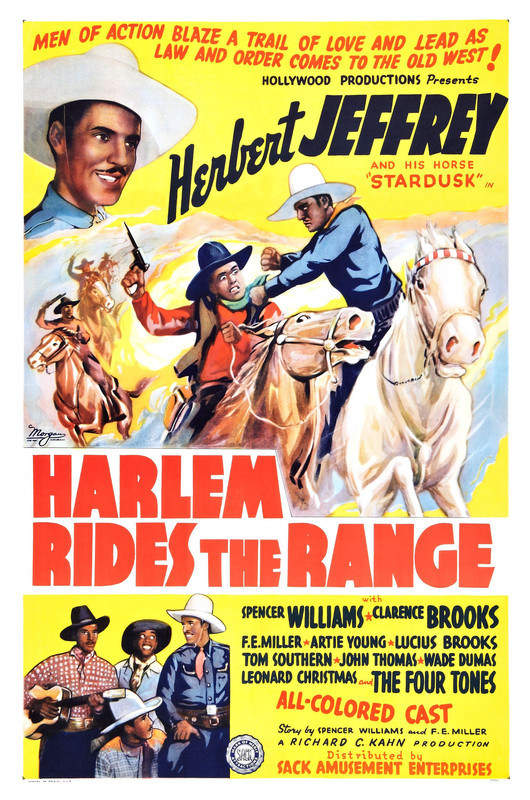
The resulting film "Harlem On The Range", was shot in less than a week in 1937 on a California dude ranch on a low budget. The plot for this film (which is not currently available) was boiler-plate B movie Western fare; A former outlaw (played by Williams) returns home to find the gold from a robbery he was involved with twenty years before that resulted in his entire gang being killed and the gold being hidden. But a rival gang is also searching for the gold and Williams is shot and again escapes albeit mortally wounded. He is found by a younger cowboy (Jeff Kincaid, played by Jeffries) who tries to save him and before he dies Williams tells him about the gold who promises to share the gold with Williams' daughter. Jeffries goes off to find the gold accompanied by the comic relief team of Miller and Moreland and the Four Tones who provide backup for a couple of musical numbers sung by Jeffries. In the end Jeffries finds the gold, vanquishes the bad guys and gets the girl.The movie was shown in black communities in the South as well as black neighbourhoods in Northern cities where it was a hit, it was further helped by a friendly review in "Time Magazine" and it easily made back it's investment of $50,000 and would lead to three sequels.
Like most B-Movie Westerns these movies are not objectively very good. These films all have simplistic plots, cliche dialogue, wooden acting, clumsy fight scenes, muffled sound and static direction in which actors spend most of the time standing around and stiffly reciting their lines. Any actual action is shot from far away and tends to look awkward while the comedy has not dated well being of the Amos & Andy school of dumb jokes and exagerated double-takes from Moreland. However it should be noted that while these movies may be cheap knockoffs of Gene Autry Westerns they are not really any worse either since all that could easily be said of the films of Autrey and Roy Rogers as well.
"I'M A HAPPY COWBOY"
In fact it could be said that the Jeffries films are slightly better for two reasons. One is Herb Jeffries himself; While he can hardly be considered a great actor he is objectively better than Gene Autry or Roy Rogers (or for that matter Tom Mix in his one talkie serial), tall, handsome and smooth, usually dressed in stylish black with a white hat (of course) he has genuine screen presence in a way that the affable but bland Autrey and Rogers did not and unlike them he looks like he could actually hold his own in a fight whereas Autry and Rogers essentially looked like your uncle playing cowboy. Neither could throw a convincing punch and Autry was so uncomfortable on horseback that he frequently fell off. Jeffries could convincingly take out the bad guys and get the girl.
The other advantage Jeffries had was being a better singer and having better music than Autry and Rogers. Both Jeffries and Autry had started out as singers but where Autry had begun singing reedy cowboy songs on the radio and Rogers tended to rely on his partner Dale Evans to sell the songs, Jeffries had been a successful Big Band singer with some of the biggest names in Jazz in prestigious clubs all night long in front of demanding audiences who expected higher standards and had little interest in cornpone jokes. The Four Tones, led by Dusty Brooks, who would appear in all his movies, were a similarly professional group in the genre of pre-Doo-Wop R&B groups like the Ink Spots and Mills Brothers. Autry's backup bands, usually led by Smiley Bates, also a songwriter as well as filling the comic relief sidekick role, were solid enough but did not have the same variety as Jeffries and the Four Tones and their music just hasn't dated as well.
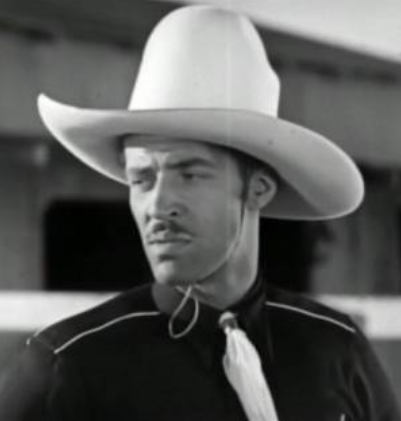
These films, both black and white existed in a strange alternate universe in which the Old West of the Victorian Era (or at least a highly simplistic and sanitized version of it) lived side by side with the modern world of the early forties leading to scenes with cowboys riding horses and wearing six-shooters who will suddenly have access to modern telephones, radios, cars and planes. The women usually wear casual dresses of the forties while the heroes wear the finest in western wear; satin cowboy shirts, gleaming cowboy boots (worn outside their tight matching pants), ten gallon hats, bolo ties and holsters, all impeccably spotless. On the other hand the villains could be dressed as forties gangsters and bankers.
These films, like similar "Race" B-movies of the era including the all-black horror film "Son Of Ingagi" (which I also wrote about here) also exist in a universe where there are apparently no white people at all. Every character, hero or villain, cops, judges, doctors, preachers, singers or businessmen are all black. White characters are not even mentioned. Black audiences presumably would have been quite happy to see white characters as villains getting their comeuppance but such films would never have made it to the screens in the south where many black theatres were owned so the villains, whether they be greedy businessmen, corrupt cops, mobsters, bootleggers or caddish lounge lizards are also black.
A year later the second film in the series "Two Gun Man From Harlem", would be made by a different white producer and director in Robert Kahn, another B-Movie veteran who would also make the rest of Jeffries' westerns. Jeffries had wanted to keep the same name as in the previous film and make the character a regular but the change in studios meant he lost the rights to the name Jeff Kincaid and so would take the name of Bob Blake for the rest of the series. The character was otherwise the same as before; cool, confident good guy wearing an immaculate costume and white hat, however for the next film he would play two characters as he would double as the villainous outlaw; The Deacon.
"TWO GUN MAN FROM HARLEM" (1937);
Directed by Richard Kahn
CAST: Herbert Jeffrey ~ Bob Blake/The Deacon
Margaret Whitten ~ Sally Thompson
Mantan Moreland ~ Bill Blake
Spencer Williams Jr. ~ Butch Carter
Clarence Brooks ~ John Barker
Stymie Beard ~ Jimmy Thompson
Mae Turner ~ Mrs. Ruth Steel
Jesse Lee Brooks ~ Sheriff
Rose Lee Lincoln ~ Dolores
In the plot, which is more complicated than the usual B-Movie Oater fare, Jeffries plays Bob Blake, a typical Cowboy good guy who is soft spoken, honest, upright, popular with women and children but who is nevertheless framed by by Ruth Steele, the two-timing wife for the murder of her husband. Forced to dodge a corrupt sheriff (Williams), Blake flees and hitchhikes to Harlem (that must have been quite a trip from the Western Plains!) where he drops in on a speakeasy where he flirts with the girlfriend of a feared gangster known as The Deacon, also played by Jeffries. Even though he's in Harlem the Deacon dresses as an Old West badman in all black with a frock coat, string tie and slim stetson. While Blake is out of town Sherrif Butch is paid off by a local businessman John Barber (Clarence Brooks) to kidnap Ruth Steele who knows about the banker's crooked deals including an attempt to foreclose on the homestead of Sally, who Blake is in love with, and her young son. After a short trip he returns to the West disguised as the Deacon who we learn has mysteriously disappeared and is believed dead. Mantan Moreland plays his brother Bill who is also the ranch's cook who sees through the disguise even though Moreland and Jeffries look absolutely nothing alike. Blake confronts Barker and the Sherrif, who try to stage an ambush, Mrs Steele is rescued and confesses, Sally is able to pay off her mortgage with money Blake robbed from Barker, Blake saves the girl, clears his name and saves the day.
One difference between the films of Jeffries and those of Autry, Rogers or Hopalong Cassidy was in the audiences for these films. The white B-movie westerns were really for kids. Usually shown on Saturday matinees these films, and others like them with or without music, had built up a devoted, even fanatical young following who not only came out every week but bought a whole trove of related merch; cowboy hats, boots & bolo ties, cap guns & holsters, pocket knives, badges, buttons and patches, lunchboxes, decoder spy rings (because cowboys were known for their secret codes), rings with compases or magnifing glasses (to start campfires with of course). There were also comic books, comic strips, story books and radio shows, endorsements for breakfast cereals, cookies, oatmeal etc for an entire, hugely profitable empire that would make the likes of Gene Autry and William Boyd (AKA Hopalong Cassidy) multi-millionaires off of movies that cost very little to actually make. Note; Roy Rogers and Clayton Moore (AKA The Lone Ranger) did not make out nearly as well due to bad contracts that meant that they never owned their own names.
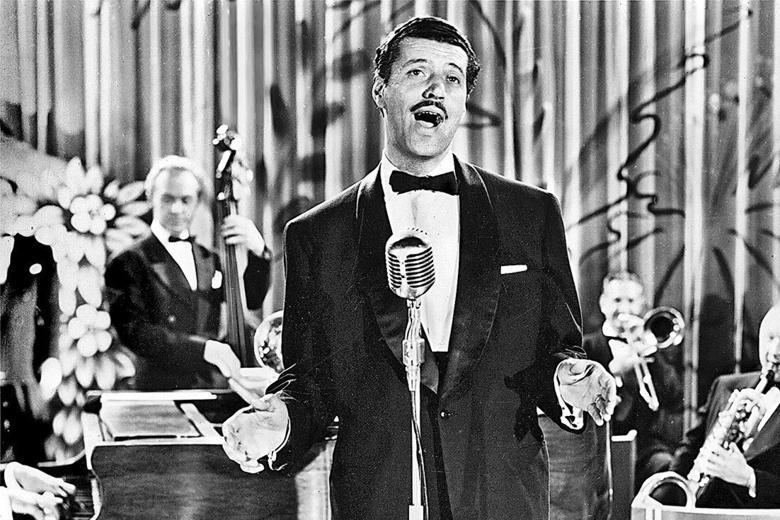
Herb Jeffries was aware of this action but the smaller, geographically and demographically limited black audience was less desirable for advertisers and investors so he was never able to capitalize on marketing his character. Unlike the white singing cowboys his audience was less focused on kids with his stories having more romance (however chaste) as is seen in this film and the music being closer to the R&B and Jazz ballad roots that Jeffries and the Four Tunes came from. "Two Gun Man from Harlem" has a subplot involving adultery and murder which would not show up in a Gene Autry or Roy Rogers film nor can either of them they be seen as romantic leading men even though Rogers was actually married to his leading lady Dale Evans. The tall and handsome Jeffires on the other hand could be marketed as a leading man however laundered for the mixed audience of kids and adults these films aimed at. However clumsily.
One of the oddities of this "Two Gun Man From Harlem" is that even though Jeffries was known as a singer he only actually sings the opening song, "I'm A Happy Cowboy" which would become his theme song, and warble a short ballad which he sings in a formal tenor. As for the rest of the songs two are done by his backup group the Four Tones with another from Paul Blackman, a one-man-band. His remaining films would feature more music.
"HARLEM RIDES THE RANGE" (1939)
Directed by Richard Kahn
Herb Jeffries ~ Bob Blake
Lucius Brooks ~ Dusty
F.E. Miller ~ Slim Perkins the Cook
Spencer Williams ~ Mr Watson
Clarence Williams ~ Bradley
Artie Young ~ Miss Margaret Dennison
For this film Jeffries once again plays Bob Blake although Mantan Morleand as his brother is now absent. Also returning was Spencer Williams who also wrote the script but only plays a minor role and as the villian Clarence Brooks playing essentially the same role as in the previous film and apparently in the same costume. With Moreland out his role as comic relief is filled by Lucious Brooks as Blake's sidekick Dusty and FE Miller as Slim Perkins the ranch cook (any resemblance to actor Slim Pickens is coincidental, he was as yet unknown). As usual along for the ride are the Four Tones.
Plotwise this film also recycles a part of the last film with Blake once again being framed for murder. Blake and Dusty are roaming cawboys in search of work when they stumble on to the farm of local homesteader Jim Dennison who was apparently murdered while being shaken down by local banker/landowner Bradley (Clarence Brooks) to whom he owes money and who has designs on the secret radium mine Dennison is hiding. Dennison also has a daughter (Artie Young) whose picture Blake sees and falls in love with. This time Blake actually gets arrested (but not before crooning a couple of numbers in a light tenor voice) and sent to jail but of course he escapes to clear his name and rescue the daughter. The climax comes in a fairly confusing gunfight in which nobody appears to actually die. This film is simpler than "Two Gun Man" and without the implied adultery subplot. Infact while in the previous film Jeffries had a romantic involvement with two women (albeit in the most chaste way possible) this time the girl doesn't even show up until the end and instead he spends the film mooning (and singing to) a photograph making this film as squeaky clean as any Roy Rogers film. Unlike "Two Gun Man" this film doesn't have the jarring shifts in time from the old west to modern Harlem and back, although a radium mine is an odd choice, in fact it has nothing to do with Harlem at all other than existing in an all-black universe that Harlem represented from the 1920's to the 1940's.
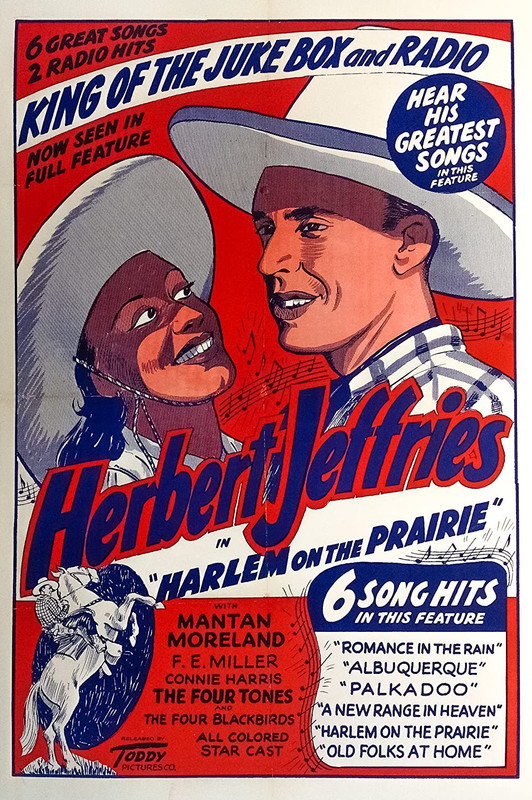
Besides having a couple more songs this film also spends more time with the comic relief characters of Dusty and Slim. This makes for some confounding questions for modern viewers. Like Mantan Morleand, Lucious Brooks and FE Miller came from the same comedy school of gentle slapstick, exaggerated facial expressions and voices and the stereotypes about lazy, perpetually hungry, loyal but not too bright and not too brave sidekicks we associate with black comic sidekicks of the era like Steppin Fetchit or for that matter Manton Moreland himself in later films made for white audiences. These types of roles are seen today as demeaning racial characters left over from the minstrel era, which is largely true but what is questionable about these films is that they were made for a strictly black audience, few if any whites would have seen them, and yet these characters are still being used. However it must be remembered that the white westerns of the same type almost always had similar oafish sidekicks, usually played by Smiley Bates or Gabby Hayes and audiences expected such antics. These were also audiences who were only a decade removed from the era of vaudeville and silent film slapstick. Also these characters are different from the hapless Fechit with Dusty and Slim riding to the rescue and taking part in a gun battle, which is something Steepin Fechit or Mantan Moreland would never have been shown doing in a film for white audiences. They may not be the heroes of the film but they are treated by Blake as trusted friends rather than strictly buffoonish clowns.
Jeffries would make one more film in the same year with the same director and almost the same cast suggesting they were probably filmed in rapid succession.
"THE BRONZE BUCKAROO" (1939);
Directed by Richard Kahn
Herb Jeffries ~ Bob Blake
Lucius Brooks ~ Dusty
F.E. Miller ~ Slim Perkins the Cook
Spencer Williams ~ Pete
Clarence Williams ~ Buck Thorne
Artie Young ~ Betty Jackson
All the major players from the last film have returned with Lucious Curtis, F.E. Miller, Spencer Williams, Clarence Brooks and Artie Young all played their usual roles. By this point the series was running out of gas and they seem to be going through the motions with the plot, when they get around to it, being meandering and dull. While the film ups the ante in having not one but two confusing gunfights little actually happens and the film spends too much time on a subplot involving the comic sidekicks being even more dense than in the last film. Williams plays the chief villain again with Williams as his minion and Young as the Damsel in Distress. Although Willams is on board to act he is not credited on the script this time. Maybe he was working on something else, he does seem to have been rather busy. At any rate his input into the script is missed here. Nobody has ever said that Spencer Williams' scripts were clever, witty or suspenseful, but he was a professional and knew how to establish the plot, stay on topic and wrap things up in an efficient manner. Here the movie takes too long to get to the plot, then rushes through it in a haphazard way. Meanwhile the film spends more time with the comic relief duo than it does with the hero.
However while the film may be the least of Jeffires westerns it does have two noteworthy moments. One comes during a scene in a saloon where the entire room full of gambling cowboys sings "Almost Time For Roundup" while a tracking shot moves through the bar. This is actually a fairly complex shot that would have taken time to stage and shoot and is unusual in a low budget quickie film of this sort, black or white. Then there is the song itself; superficially in a similar vein to the Western Ballads of the famous white vocal group the Sons Of The Pioneers (of whome Roy Rogers had been a member) at least subject wise, is sung as a call & response style having more in common with black traditions of Gospel and Blues than would be found in a white western film. The other track, "Payday Blues" is an upbeat vocal track similar to some of the more upbeat number of vocal groups like the Mills Brothers along with a tap dance solo which is distinctly not western but is reasonably contemporary for black audiences.
"IN MY HEART"
This would turn out to be the last of Jeffries western films either due to less audience demand, the movies not making enough money or his own boredom with the limits of the project. He would not lack for work however returning to his singing career for the throughout the forties and fifties as a Big Band singer for several record labels. In his early years he sang with the lilting tenor he used in his films but afterwards as musical tastes evolved into a deeper baritone voice as he worked with more blues influenced musicians like pianist Joe Liggins and His Honeydippers with whom he scored a chart hit in 1945 with "Left Good Deal In Mobile". After the war like many other black American artists he spent time touring Europe.
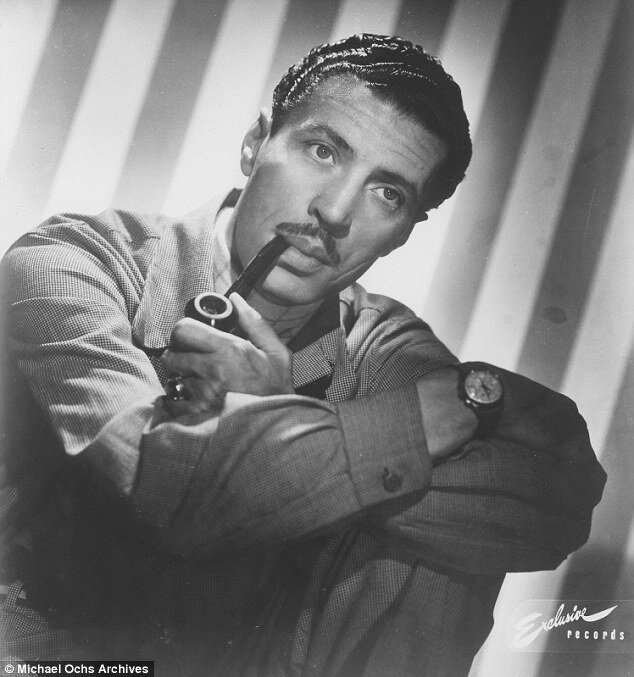
The coming of the Rock & Roll meant that many R&B band singers like Wynonie Harris, Roy Brown, Louis Jordan, Slim Gaillard, Brook Benton and Big Joe Turner would join in but Jeffries was too smooth both as a singer and in his image to credibly be a Jump Blues shouter. Instead he cashed in on another craze as in the late fifties there was a brief fad for Latin Jazz and Calypso leading to a few forgotten movies including Jeffries' own "Calypso Joe" in 1957 starring Angie Dickenson. The Calypso craze didn't last long however and Jeffries would return to his career singing Jazz ballads and marrying burlesque star Tempest Storm.
His status as the first Black Western star would not be totally forgotten however and in 1969 he would make an appearance in the TV series "The Virginian" as a villainous gunslinger. He would make a few other non western TV roles as well. In 1979 he would be added to the Black Filmmakers Hall Of Fame and the Hollywood Walk Of Fame. In the 1993 Black western "Posse" (directed by Mario Van Peebles) a clip of Jeffries from one of his films can be seen during the closing credits although for some reason he is not in the film itself. Perhaps at age 83 he was too old or ill to work. He died in 2013 aged 100.
As for the other main players; Spencer Williams would continue with his varied career as actor and filmmaker making films from genres as different as religious films "The Blood Of Jesus" (1941), "Go Down Death" (1944) musicals "Juke Joint" (1947) and "Beale Street Mama" (47) along with the first all Black horror film "Son Of Ingagi" (1940) (which I also wrote about here) all done on very short budgets and shown entirely to black audiences. He became best known however from the hit TV series "Amos & Andy" from 1951 to 1955. He did not originate the role of Andy and in fact both roles had originally been played on the radio by white comedians Freeman Gosden and Charles Correll who owned the rights to the characters but obviously could not play themselves on TV and so recruited experienced black vaudeville and film actors largely unknown to white audiences to play them with Williams as Andy. The show was an immediate hit with, white audiences at least. However the characters were obviously stereotypes left over from Minstrelsy of Blacks as sneaky, lazy, illiterate, hustlers speaking in exaggerated accents that were already seen as retrograde and offensive to Black audiences who had already been offended by the long running radio series. Once the series wrapped up, Williams, by now thoroughly typecast in a role that Blacks found deeply demeaning and even many whites found problematic, found little employment. The chain of Black owned theatres that he had provided films for in the 1940's was largely gone and the Black Vaudeville comedy circuit was barely a memory. He made do with some stage and comedy work, writing his memoirs and living off his WW1 US Army pension. At the time of his death in 1969, aged 76 he was remembered only for his work in "Amos & Andy" with his many Black films being almost completely forgotten (they had never been seen at all by white audiences) and considered lost until some of them were found in a warehouse in the 1980's and restored.
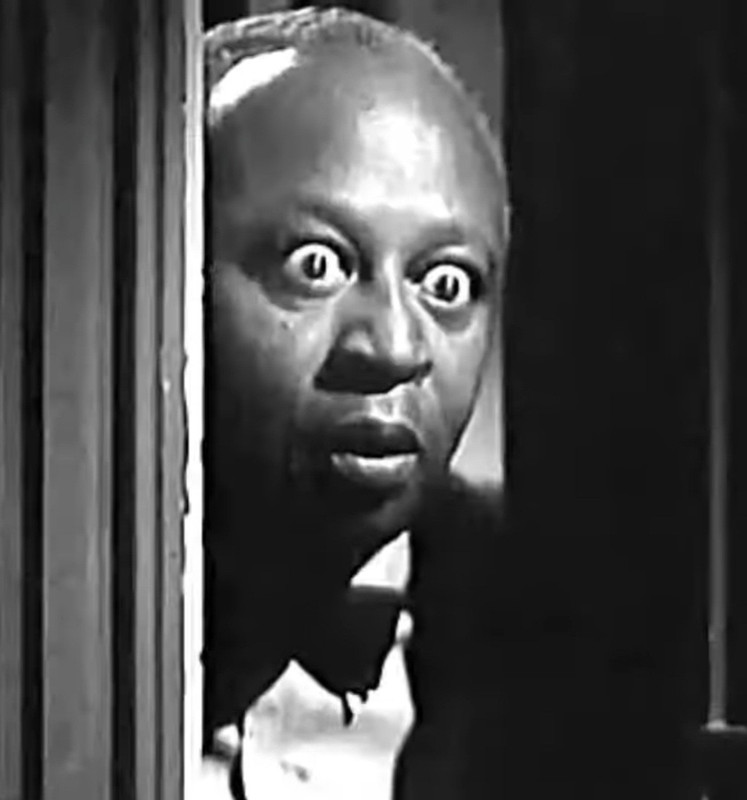
MANTAN MORELAND
Similar fates followed the other comic actors from the series; Mantan Moreland would have a prolific career outside the closed world of Black Cinema in Hollywood itself invariably playing the same basic comic relief role in b-movies ranging from comedies to musicals to crime movies. Notable film roles included the recurring role in the Charlie Chan series and a couple of zombie films with John Carradine. By the end of the fifties his typical comic role of exaggerated pop-eyed reactions and reddy high-pitched voice had gone out of fashion but he was still respected for his comedic skills that Moe Howard seriously considered inviting him to join the Three Stooges to replace the ailing Shemp Howard as the Stooges were fans of his work however the studio insisted on adding the white Joe Besser. Moreland still had better luck than Spencer Williams finding work in smaller roles as well as touring Black night clubs with comics Nipsey Russell, Redd Foxx, Moms Mabley and Bill Cosby. Carl Reiner was also a fan and gave him some work. He died in 1973 aged 71.
Flournoy Miller made no other films after the Jeffries series but he continued to work on Broadway stage in further productions of "Further Along" and a production based on the life of Eubie Blake. He would also work with Spencer Williams on the "Amos & Andy" series as a writer. He died in 1979 aged 86 and was awarded a posthumous Tony Award in 1979.
Clarence Brooks actually had a long career dating back to the very first Black movies in 1916 but he made only two more movies, both low budget quickies. Both were for the Black theatre circuit, one with Mantan Moreland. With the circuit drying up in the 1940's he found work in Hollywood in a few bit parts. Unlike Moreland and Miller he was not a stage or comedy performer and by the 1950's he quit show business, dying in 1969 aged 74.
The legacy of Black comic actors of the era like Williams, Moreland and Miller (along with contemporaries like Stepin Fetchit) is complex. For decades their routines of exaggerated eye-rolling and double-takes, playing characters pulled from from Minstrel Show stereotypes of shuffling servants or shuckin' & jiving hustlers, lazy, cowardly, gullible, childlike and perpetually hungry were seen as demeaning throwbacks to a shameful era and an embarrassment. However some modern black film historians have given them a more sympathetic take noting their ability to have long careers in an era of open segregation, the subtle ways they inserted humanity into their roles and the genuine respect in which they were held by their peers both Black and White for their talents. Moreland was praised as a mentor to a future generation of black comics like Redd Foxx and Nipsey Russell while Spencer Williams is noted for his work as a director and filmmaker for his success in getting a string of all-black films made and released with his religious films having deep meaning for Black American culture of the mid-twentieth century.
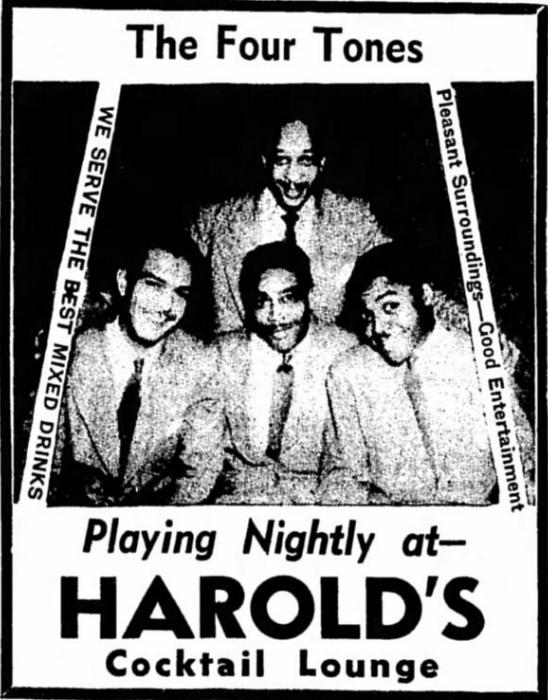
Although he also played the comic sidekick role, the career of Lucious "Dusty" Brooks would be more focused on music. Born in 1911 in Oklahoma and based out of Los Angeles, he made only a few more minor film appearances, usually in brief singing roles and sometimes with the Four Tones, including "You'll Never Get Rich", a Fred Astaire film. His film career ended in 1947 then he largely stayed in Los Angeles and continued his musical career recording several singles for various labels along with a group billed as the Four Tones, although whether it's any of the same Four Tones from the westerns is unknown. Musically these singles are in the sort of Urban Jazz/Blues style popular on the West Coast in the post war era with a vocalist and a small band. Among the last of these is a mysterious single released by the iconic Sun Records label in 1953. Based in Memphis and run by the flamboyant Sam Phillips, Sun Records was soon to be famous as the label for Elvis Presley, Johnny Cash, Jerry Lee Lewis, Carl Perkins and Roy Orbison among others. However some of it's first few records were actually licensed from smaller labels from out of town or demos sent in from elsewhere with this record, only the seventh put out by Sun, reportedly coming from Los Angeles where Brook's other recordings were done. Sam Phillips' record keeping was notoriously spotty and since the record was not a hit there was even less reason to take note of it but the singer is billed as Juanita Brown and the male on the duet as Joe Alexander. Brown was considered an up and coming Jazz singer while Alexander was a veteran Big band singer based in Los Angeles.
DUSTY BROOKS & HIS FOUR TONES w/JUANITA BROWN & JOE ALEXANDER ~ "HEAVEN ON FIRE" & "TEARS & WINE";
Previously Brooks had been the band leader and singer but at this point they were acting as Brown's backing band with Brooks keeping top billing as the bandleader, a not unusual practice at the time. Though we know from ads placed in various black newspapers that Brooks and his band spent the early fifties touring through the south, southwest and midwest, including with Brown in 1953 and 54. We also know there was also a 1953 recording session listed as happening in nearby Nashville which were never released. This record however was probably recorded back at Los Angeles though as that was Alexander's base and there's no indication that he ever toured with the band. It's possible that Brooks simply dropped it off at Sun while his band was touring through Memphis. That Brooks has the main billing on this record suggests he himself cut a deal with Phillips as the ads show Brown as having equal billing.
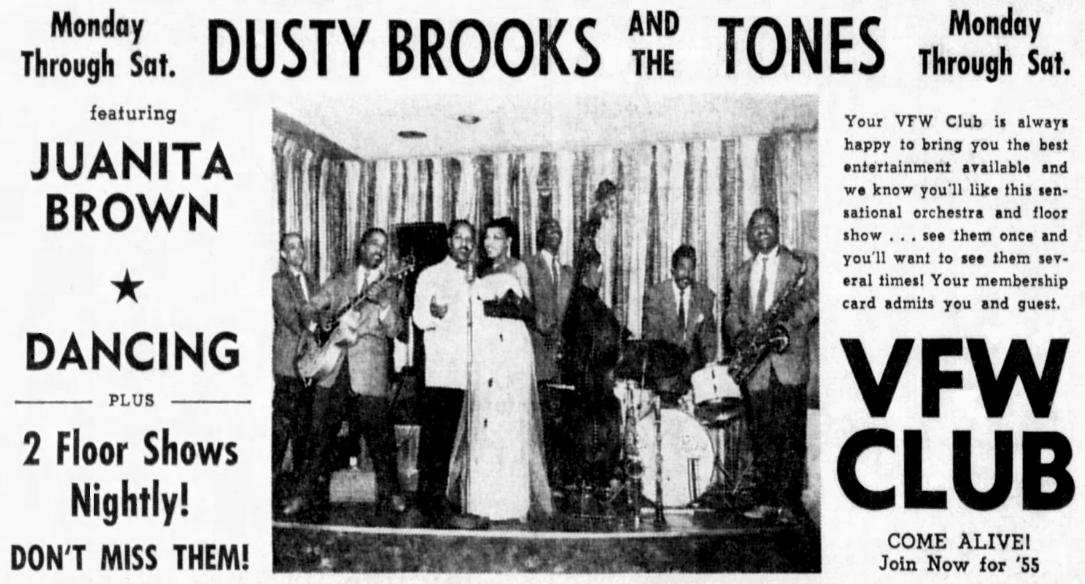
He may have even used a previous as yet unreleased recording to make a quick deal to cover expenses if the tour was having problems. In fact this was Brooks' last recording and by 1955 ads show Juanita Brown is now touring with a new band led by Art Maryland who had been the guitarist in the Four Tones so it's obvious that Brooks was now gone. Neither Brown or Maryland surfaced again and neither would Brooks for almost a decade until a brief mention in the 1963 minutes of the Los Angeles chapter American Federation Of Musicians notes that Rusty Brooks has been reinstated as a member. It would seem that after 1954 he quit the road, returned to L.A. and at some point retired, long enough to have let his membership lapse before changing his mind in 1963. Thereafter he drops out of sight again. By this point he was in his fifties which is hardly old but the musical world had changed in a decade with Rock & Roll and Soul replacing the R&B he knew. Probably he found work in a little Jazz club (thus the need to renew his AFM membership) but did not record or appear in movies again. At some point he retired again and dropped out of sight for good until dying in Missouri City, Texas in 1999 aged 88. The career of Dusty Brooks is not that different from dozens of other similar band leaders of the era just before Rock & Roll like Doc Wiley, Todd Rhodes or Art Hodges; a bunch of decent recordings for small local labels, backing up minor singers and a life on the back roads of America. Where Brooks gets his footnote is from the four films he made with Jeffries and the one obscure record he made for Sun Records, a label soon to be famous. Of that record, due to it's status on Sun Records and it's rarity, copies can sell for several thousand dollars, which is probably more than Brooks made for his entire film career.
DUSTY BROOKS ~ "PLAY JACKPOT"
A final word about Paul Blackman, the one-man-band from "Two Gun Man From Harlem". These type of one-man-bands were an odd niche genre of the era that included the likes of Dr Isaiah Ross who would also record for Sun Records in it's early days and Bongo Joe Coleman who recorded an album for Arhoolie Records in the sixties. Blackman was originally from New Orleans and seems to have travelled around making his way to Hollywood and later up to New York where he would later record an album for the Smithsonian/Folkways Records label in 1957. What happened to him after that is unknown but it's probably safe to assume he's not arround anymore but thanks to Folksways practice of always keeping their titles in print his album is still available.
PAUL BLACKMAN ~ "BASIN ST BLUES"
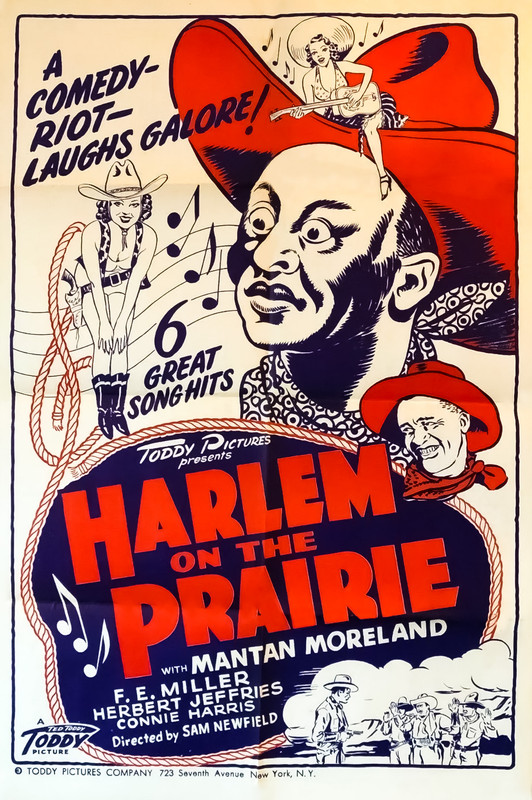
NOTE THAT MANTAN MORELAND GETS TOP BILLING ON THIS POSTER
